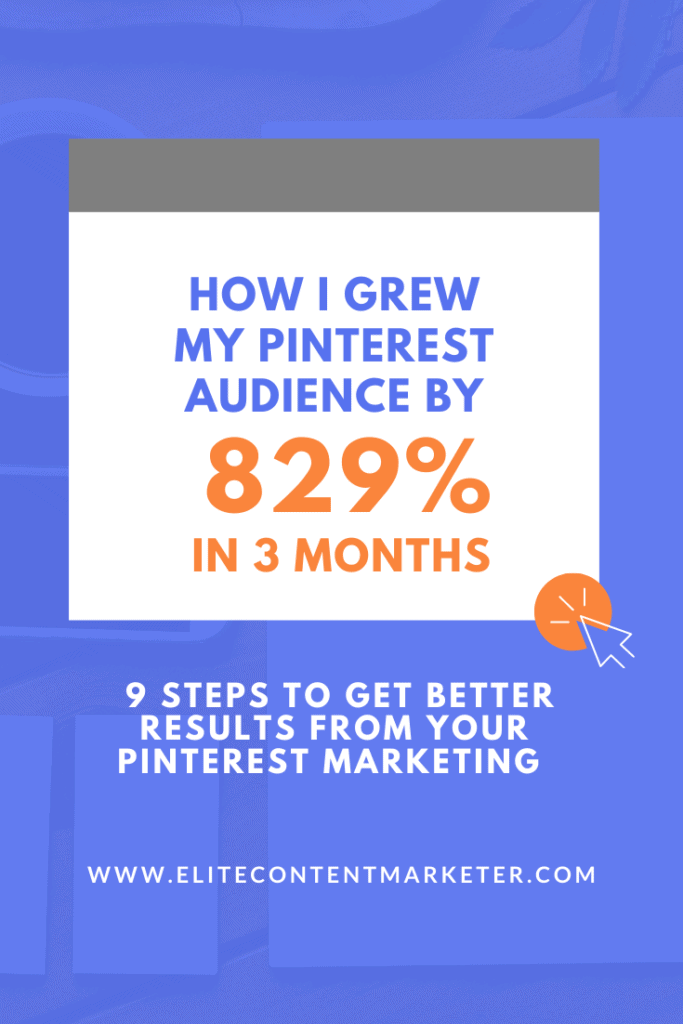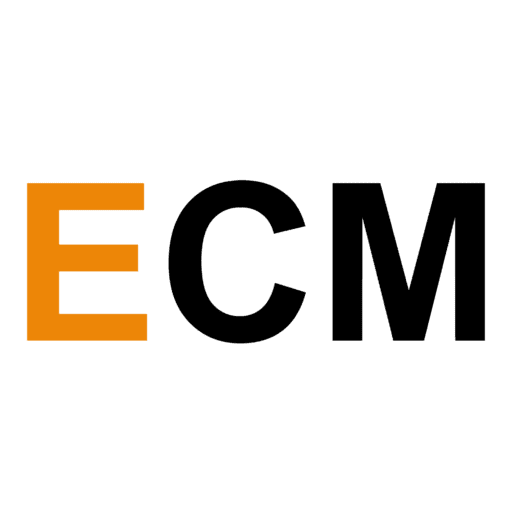Hey guys, Chintan here. Shreya, the founder of The Creatives Hour, has been managing the Elite Content Marketer (ECM) Pinterest account since the very beginning. She started devoting a serious amount of time to it in April 2020. Within a couple of months, she managed to grow the Pinterest audience by a whopping 829 percent. She shares how she achieved the feat in this article.
Pinterest is probably the only social media platform that wants its users to get inspired, then get offline from the platform to create. In that regard, it’s also generous with letting businesses drive traffic to their website organically. Yep, I’m talking about free brand awareness and traffic to your site!
As Chintan mentioned, I managed to grow the ECM Pinterest audience to 410k within a few months. It was rooted in a well-executed strategy that I would love to share with you today.
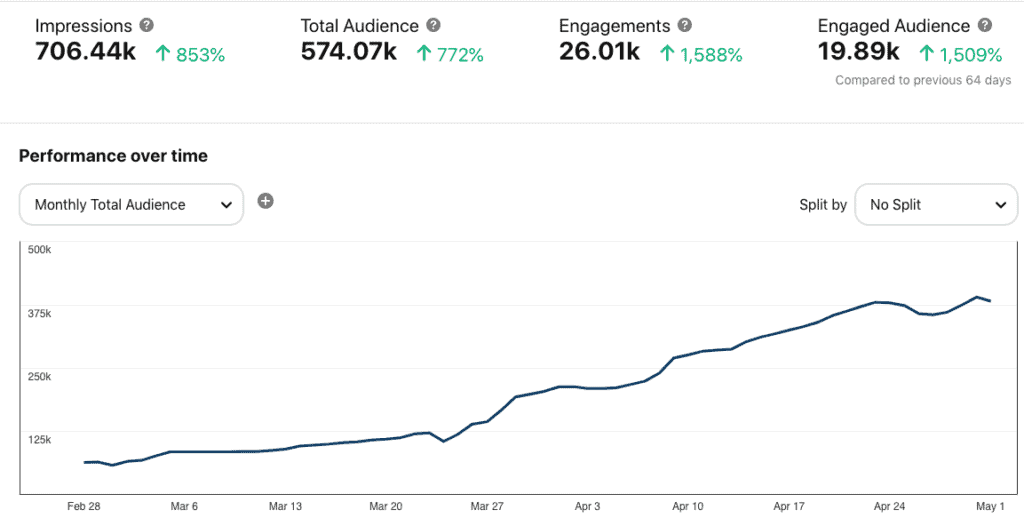
Note: This case study contains affiliate links, meaning that if you choose to click through and make a purchase, I will receive a small commission (at no extra cost to you). I was also compensated to create this post, though all opinions are my own. I appreciate your support.
Let me walk you through the strategy I followed, the importance of analytics, beginner pitfalls, and the tool that was incredibly valuable in my journey – Tailwind
Before I get into the specifics of the strategy that I used to get these results by using Tailwind, I want to highlight that these are my personal results achieved through experimentation. The results will vary for different niche blogs. However, Tailwind publishes the “Typical Results of Tailwind Pinterest Members” every year, so you can see exactly what the average growth rate looks like for their members.
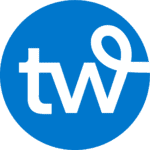
Pinterest Strategy To Follow When Getting Started
When I started Pinterest marketing for ECM, we had about 30 articles live on the site. It was enough to get the wheels turning. So I began with using Canva to design vertical graphics for the articles and Tailwind to conveniently schedule pins throughout the day.
The first ingredient of my strategy was:
Consistent (Fresh) Pinning
Pinterest has ruthlessly started prioritizing distribution of fresh content in its feeds. So, let’s begin with understanding what exactly the term “fresh pins” means:
“Fresh Pins are defined by Pinterest as images or videos that they haven’t seen before. You can create several images that link to the same blog post, page, or product listing, and each of those would be fresh when saved to Pinterest for the first time.”
Simply put, every new pin image counts as a fresh pin even if the URLs are repeated. Read more about fresh pins in this Tailwind article.
A new Pinterest account needs a healthy amount of pins to start garnering visibility for your brand. But having only a few blog posts (or pages) is not a roadblock. Like in our case, I could create multiple pins for a single URL from the site by tweaking pin design templates, colors, and the pin text. I recommend getting creative with pin designs.
Now, let me answer some of the most common questions around pinning and share what worked well for me.
Is there a recommended pinning frequency?
When I started taking Pinterest marketing seriously, I ensured consistent pinning at a cadence of about 15 to 20 fresh pins per day.
That’s along the lines of Pinterest best practices. Tailwind claims that “pinning over 50 times per day can significantly hurt your content distribution on Pinterest.”
How to create multiple pin designs for each pin URL?
Here’s how I got creative with pin design — crafting multiple graphics for the same post. Some of these design tips might be helpful for you.
- Varying the text and design to create new design templates for a blog.

- Mini-infographics for more informative blogs
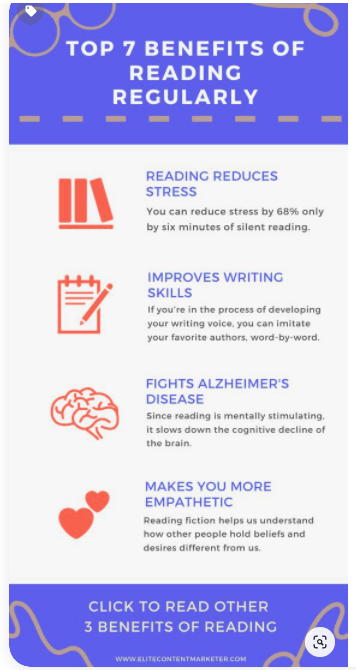
- A separate graphic for every idea in a listicle article with a CTA at the bottom to read the complete article. For example, each of the writing ideas from the post “things to write about” could be made into a Writing Prompt idea pin.
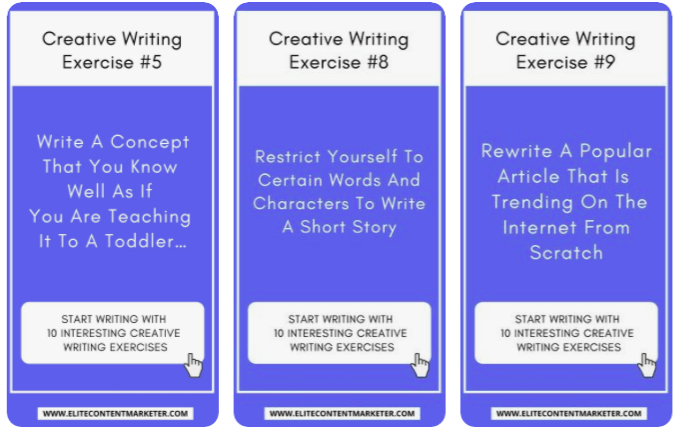
- Grouping similar ideas from a blog post in a single pin.
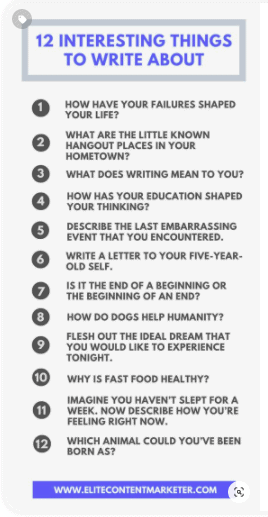
Can you send multiple pins to the same URL on the same day?
Even if you make unique pin designs, avoid pinning more than one pin for a URL on a single day as there are chances that it may come across as spam. You can schedule one fresh pin for a certain URL every day.
Should I create multiple fresh pins for each blog post that I publish?
Yes, and no. You should create at least 5 fresh pins for every blog post that you publish. However, not all blog topics perform well on Pinterest. If you didn’t get any engagement on your first 5 fresh pins, do not waste time designing too many pins for it. Pick the blog posts that are performing well and create more fresh pins for them.
One month into creating graphics for every article and pinning them consistently, I identified that only 15 out of 30 articles from our blog were getting traffic from Pinterest. When I focussed on designing fresh pins for only those 15 articles and increasing the pinning frequency to one fresh pin for each article per day, I saw an uptick in traffic.
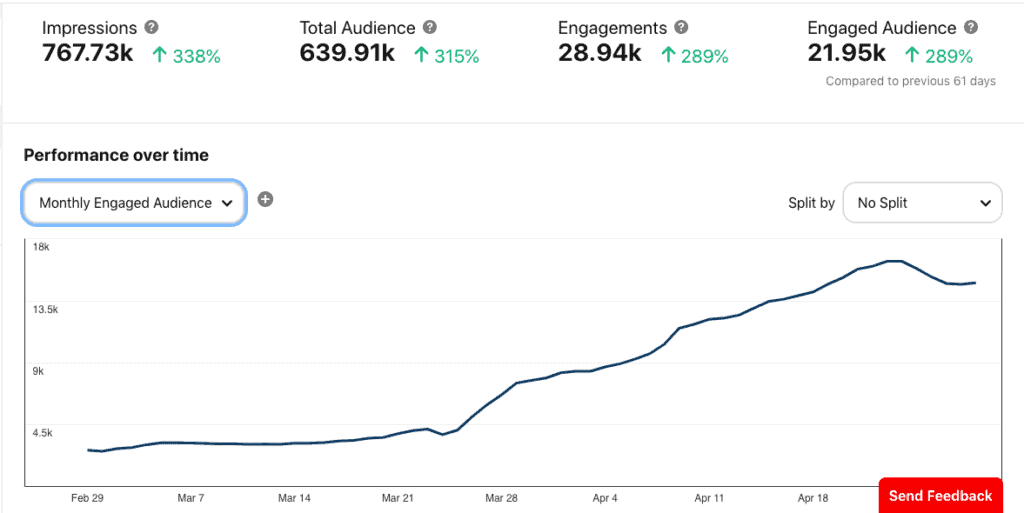
Optimizing For Pinterest SEO
Pinterest is a unique combo: it’s a social media platform as well as a visual search engine. The discovery of pins by users is similar to how people find content using Google — through keywords.
A fresh pin gets impressions and clicks by getting mapped to the keywords that users are searching for. So, you’ll need to weave keywords into your pins. The three prominent places for doing the same are:
- Pin title,
- Pin description,
- Board titles and board descriptions
The first board you save your pin to is the most important. This board must have the relevant keyword in its name. Pinterest uses the board’s name (and the other pins saved to the board) to get more context about your pins. Also, write a keyword optimized description for every board.
Here’s how I plan a keyword optimized board description for my boards.

I also plan multiple variations of titles and descriptions for each blog post after doing proper keyword research.
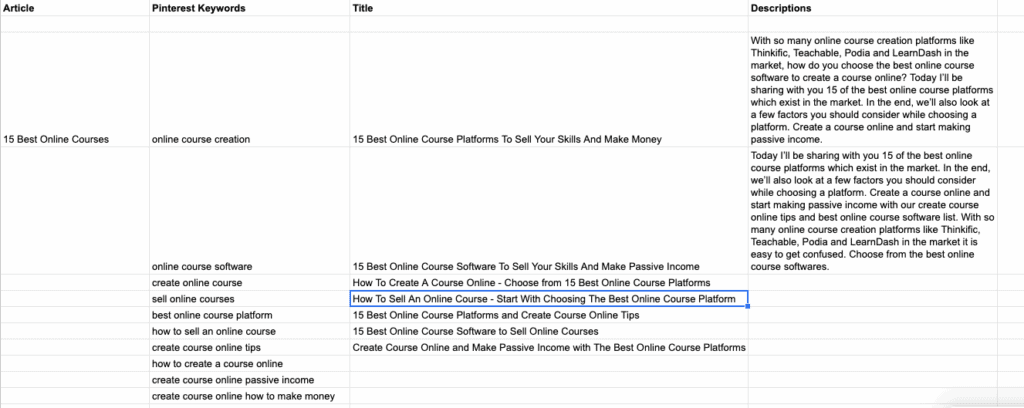
At ECM, the articles were written and optimized for Google SEO. Mapping the articles to relevant Pinterest keywords was very helpful in driving organic traffic from the platform.
Your Pinterest SEO keywords and Google SEO keywords for the same article could be very different. For instance, the article optimized for keyword ‘things to write about’ for Google will get visibility on Pinterest through a Pinterest keyword like ‘writing prompts’ or ‘writing exercises’.
Consistently pinning with keyword-rich titles and description was a major reason for growth of the ECM account steadily from under 100K monthly viewers to over 400K monthly viewers in less than two months.
If you want Pinterest to be the main traffic driving channel for your blog, then Pinterest Keyword research is of utmost importance for you. I strongly recommend that you perform Pinterest keyword research to plan topics for your blog posts. The next section talks about how you can do that.
Make Your Content Calendar ‘Pinterest-Friendly’
If your content strategy doesn’t take Pinterest distribution into account, you’ll struggle with generating traffic on the platform — there might not be a sufficient demand for the topics you write about. So research what kinds of subjects are in demand on Pinterest and plan a few articles based on them in your calendar.
For example, we wanted to push our YouTube articles from ECM to gather some traffic from Pinterest. When I pushed out pins for the articles on YouTube tools and YouTube promotion strategies, they got lukewarm visibility.
Pinterest keyword research later revealed users searching for slightly different subjects around YouTube. These included YouTube channel ideas, YouTube video ideas, and more.

I also asked Chintan to write a few articles on the YouTube related subjects that were in demand on Pinterest.
Similarly, we also sanctioned a few articles on writing quotes, creativity quotes, and time management quotes as keyword research showed demand for them — and they drove lots of engagement to our Pinterest account.
Leveraging Pinterest Analytics To Improve Your Performance
I use Pinterest Analytics and Tailwind Reports to measure and analyze the performance of the ECM Pinterest account. To check the clicks to ECM from Pinterest, I also track the sessions from Pinterest through Google Analytics. Kristie Hill has created a custom Pinterest dashboard that proved super helpful to me. Broadly I look out for these answers through analytics:
- Which keywords and pins are driving the most impressions and clicks for my account.
- Which pins got impressions but failed to get enough clicks? (Also contemplating design changes to improve the CTR).
- Which pins are failing to drive any impressions or clicks and why?
I also try to stay on top of our ‘best performing pins’ and stay focused on how Pinterest is helping my bottom line.
Identify Your Top Pins
A few days back, I revived an older best performing pin (with a healthy CTR of 2.6%) from August last year. I repinned it to the original board and it started getting more link clicks and impressions.

If you want to see how a pin has performed over time, you can click on see more stats. You can then toggle to see the stats for 24 hours, 7 days, 30 days, or 90 days.

Another way to identify your best-performing pins is by using the Pin Inspector on Tailwind. Go to the Pin Inspector and click on Top Pins. Here you can view your best pins sorted by the number of clicks or saves. You can only see the top pins from the last 30 days here.

If you want to identify the best pins across the last two to three months, then you can use Pinterest Analytics. After choosing a suitable time period, ensure that you toggle to the “your domain pins” option right below. Then scroll down and sort your top pins by link clicks.

While you can repin all your content, I was selective with it. Repinning the top pins from every week and month to other relevant boards (your own or niche group boards) and Tailwind Tribes is a good practice. Once in 3-4 months, I even repinned the best-performing pins to the same board.
Identify Your Top Boards
If you’re a part of several group boards, then you can use Tailwind Board Insights to evaluate their virality and engagement score.
Being a part of irrelevant and crowded group boards can affect your account negatively. While you can experiment with broader and low engagement group boards at the beginning, leave them as soon as you get accepted into niche-specific and high-performing group boards.

You can also use the analytics to identify your own boards with the highest engagement score. This will give you an insight into what content is performing the best on Pinterest. Just select ‘Regular Boards’ to view the performance of your own boards.

Getting More Link Clicks
It’s easy to get caught up in the plethora of metrics such as impressions, engagements, saves, and monthly viewers on Pinterest. But all of these are about brand awareness. The metric that should probably matter the most to solopreneurs and small businesses is link clicks — as it lets you generate profitable actions from a customer on your website.
I made the mistake of not focusing on them, so only the viewership of our Pinterest account grew. I’m now fixing it by translating the pin engagements into clicks to the ECM articles even if we lose our account’s reach.
I reckon that low CTR (Click Through Rate) means a pin is probably not ticking one of these three boxes: design, branding, or pin text. By optimizing for link clicks, I’ve been able to increase the CTR to about 1 percent from 0.2 percent (even though our account’s monthly viewership dropped below 1000k monthly viewers).
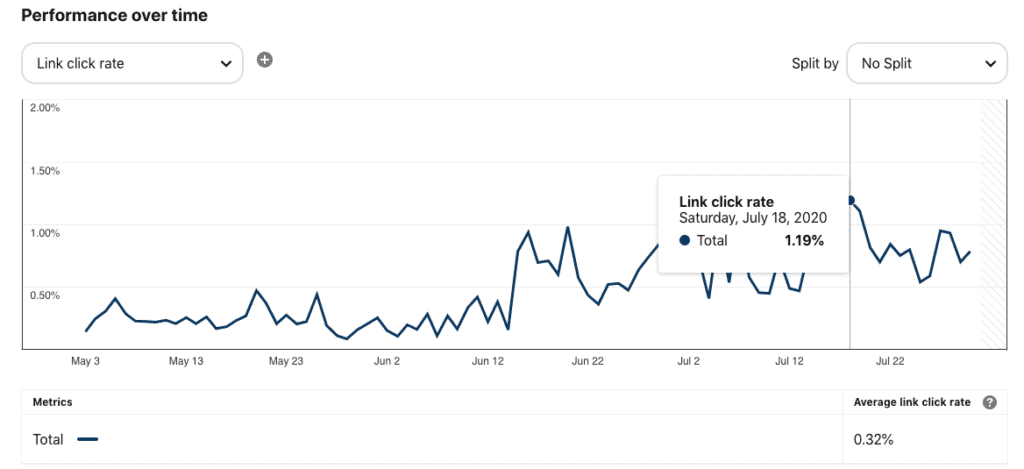
For ECM, I consider our branding and design pretty decent. So I’m now investing my time in polishing my copywriting chops to make the text more click worthy.
Overrated Pinterest Tactics You Can Give A Miss
Finally let me talk about my experience of implementing a few overly shared Pinterest marketing tips, hacks, and ideas that are widely shared by experts. There are the strategies that failed at driving significant business results through them. Here’s the first one:
Creating Pin Graphics With Slight Modifications
15 ‘fresh pins’ per day might lead you to think about “mass producing” graphics by batching the design process. Some marketers recommend that you simply change the pin image or font color to create multiple versions of the same pin.
You know what? I tried this process of batching for a while. Sadly it didn’t contribute to the overall growth of the account. I guess, even with the number of pins you create, the quality still matters a lot. It’s better to put some thought into each pin I design.
Also think about pin text:
- Is it compelling enough to make users want to click the pin?
- Is it addressing any target audience?
There are many ways to get creative with the pin design. Whenever I actually put more thought into designing the pin, I got better engagement.
This is an older pin that continues to bring clicks and has an excellent CTR of 2.9%. The pin text, title, as well as the description give a clear idea about what to expect from clicking on this pin.
Pinning to generic group boards
I spent a serious amount of time trying to get accepted into group boards because they seemed promising for virality. In a few months, I analyzed the performance of my pins on those boards and found that they were barely driving any clicks.
I concluded that if a group board accepts a beginner like me easily, it probably doesn’t have power Pinterest users who will help the engagement for my pins.
Right now, I have stopped focusing on group boards because I am not sure if they are worth the effort. In the future, I think it will be better to find uncrowded niche group boards relevant to the ECM account. These boards might be hard to get into, but they will work better than the generic communities.
Pin Every Pin To All The Relevant Boards
While Tailwind is amazing and I’ve pinned everything at ECM using it, I realized the problem with using too much automation.
After reading a few blog posts about Pinterest Marketing, I decided to give Tailwind’s board list feature a try. Board lists let you categorize your boards into various broad topics. Every time you create a ‘fresh pin’ you can add it to a relevant board list and set a gap time interval between pinning to the boards on that list.

While this is time-saving and lets you create multiple repins at once, I only benefitted a little from this. My time slots got super crowded with the repins, making it very hard for me to manage them all and find slots for fresh pins.
Again, as I mentioned before, I consider selective re-pinning a better alternative to this. Just because you can repin all your content, doesn’t mean you need to.
Conclusion
The following strategies have helped me scale the ECM audience and link clicks from Pinterest.
- Following a consistent pinning schedule,
- Performing Keyword Research for optimising the text in titles, descriptions and boards,
- Selective repinning of pins that perform well,
- Creating new fresh pins for blog posts that perform well on Pinterest,
- Getting creative with pin designs,
- Optimizing pin texts to increase CTR.
If you’re just getting started with your blog and want to use Pinterest Marketing to grow it, I strongly recommend that you invest time in learning about Pinterest trends as the demand for content varies according to the season. You can also grow your account by planning your content for these seasonal trends.
Also, if you’re considering using Tailwind for your Pinterest Marketing, you can avail a discount using this affiliate link. Please note that Tailwind’s free trial also lets you schedule 100 pins. Tailwind is an official Pinterest partner, and you can follow their posts to stay updated on the latest Pinterest marketing best practices.
Which Pinterest Marketing tactics work the best for you? Do you have any unique insights from your experience? Let me know in the comments below.
